The Flats
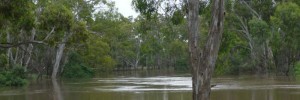
The Flats is a significant cultural area located on the floodplain between Shepparton and Mooroopna. Interpretative signage was installed in 2013 to record the history for educational and tourism purposes. Book guided tours with an Elder through Yorta Yorta Nation on 5832 0222 or reception@yynac.com.au
History of The Flats
The area known as ‘The Flats’, became home to many after the Walk Off from Cummeragunja at Barmah on 4 February 1939. The first ever mass strike of Aboriginal people, the Walk Off was due to the increasingly restrictive controls upon the movement and activities of the people, the poor rations and cruel treatment they received and the increasing removal of children.
Jack Patten, with the help of William Cooper, encouraged the people of the mission to leave, therefore resulting in the walk off to ‘The Flats’. Jack Patten received a gaol sentence for his part in enticing the Aboriginal families to leave the Cummeragunja reserve. Both Jack Patten and William Cooper were spokesmen for the dispersed Aboriginal communities of central Victoria and western New South Wales.
The particular site at ‘The Flats’ was chosen as the Yorta Yorta had an extended traditional association with the environments in close proximity to rivers such as the Kaiela (Goulburn River). ‘The Flats’ was also home to some Aboriginal families prior to the Walk Off.
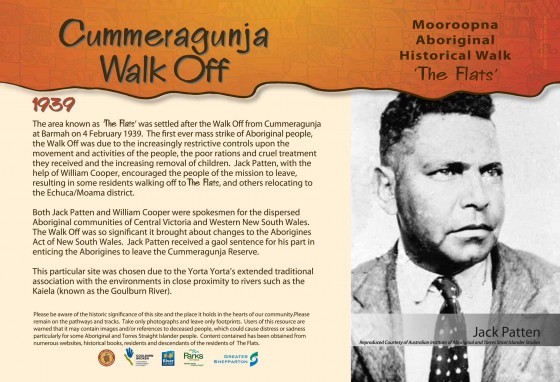
The River
The river provided abundant food including crayfish, red fin, yellow belly, cod, turtle, turtle eggs, swan, duck, crane and water fowl and their eggs. The area also provided possum and rabbit for consumption. Unlike what you see today, the river water was clear, which made fishing and the collection of crays easier. The women would collect most of the fish while the men would hunt for rabbits by smoking them out of their burrows and then hitting them with a boondie (club).
The river had a number of water springs, which would run down the banks. It was cold, crystal clear water and was utilised for drinking and to keep food cool. The river was also used for bathing and washing clothes. Pulleys were used to haul water up the steep banks from the river.
Flooding occurred most years with the water always rising quickly. In each event, the people of “The Flats” vacated to Daishes Paddock, with many choosing to remain on site here due to the recurrence of the floods. This site is now home to KidsTown Adventure Playground.
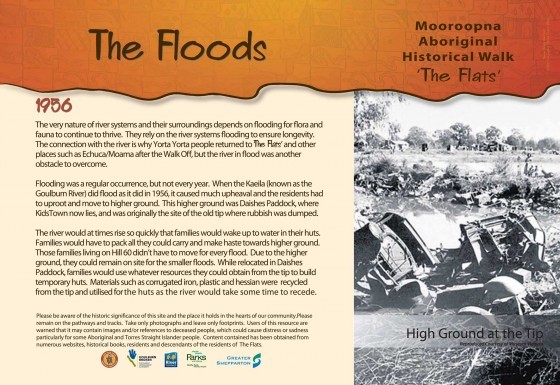
River life and housing
Housing on the Flats area consisted of tin or bag huts and tents. When newcomers arrived at “The Flats”, they camped under the bridge whilst building their own dwellings, of which the community contributed and helped by sewing together hessian bags for the walls and collecting scraps of metal for the roof and chimney. Though limited in resources, there was a sense of community with the people creating a real “home” as best they could.
A September 1946 police report listed 130 people aged from 8 days to 80 years living on the Flats, with a third of them less than 15 years of age. Lodgings consisted of 29 dwellings, 22 being assortments of tin or hessian bag huts and the rest tents. The dwellings housed extended families and the sense of community was strong. By the early 1950’s, it was believed that the numbers had grown to approximately 300 people.
Winter posed many hurdles to overcome when undertaking household chores. Cooking occurred outdoors the majority of the time on individual fires, with the exception of those who had indoor facilities and a chimney in their home. When the weather was bad, it made it difficult to cook and to dry washing. The wet and the damp ground made sickness rife due to the conditions. As many lived in tents it was difficult to keep illness and pneumonia at bay.
Most of those who lived on “The Flat” remember life as a hard, but a happy time.
Interpretative signage was installed in 2013 to record the history for educational and tourism purposes.
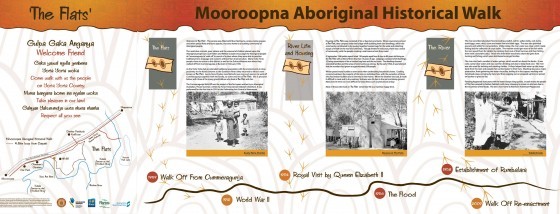
List of Yorta Yorta people who served in International Wars
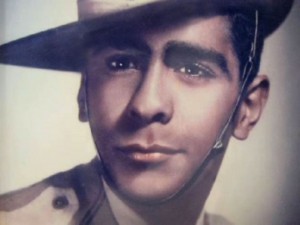
This list includes only those submitted to RiverConnect and may be incomplete. Please contact RiverConnect if you have any other names for submission.
-
Aaron Briggs
Service: Army (World War II), Service No. V331582
Rank: Gunner
Summary of Unit name: 3rd Field Training Regiment
Dates of service: 10/4/1942 to 12/9/1942 (156 days of service) -
Oliver Jackson
Service: Army (World War II), Service No. VX42099
Rank: Private
Dates of service: 1/7/1940 to 15/9/1941 (441 days of service) -
Bob Nelson
-
Glenn Robert James
Service: Army (Vietnam War), Service No. 3794344
Rank and Corp: Sapper, Royal Australian Engineers
Summary of Unit name: 17th Construction Squadron
Dates of service: 9/5/1969 to 30/4/1970 (357 days of service) -
Daniel Cooper
Service: Army (World War I), Service No. 4303
Rank: Private
Summary of Unit name: 24th Battalion (Infantry)
Dates of service: Joined up 23/7/1915. Served from 8/2/1916, Killed in action – Belgium 20/9/1917 -
Leo Maxwell Muir
Service: Army (Vietnam War), Service No. 3790995
Rank and Corp: Lance-Bombardier, Royal Regiment of Australian Artillery
Summary of Unit name: 12th Field Regiment
Dates of service: 28/5/1968 to 17/12/1968 (204 days of service)